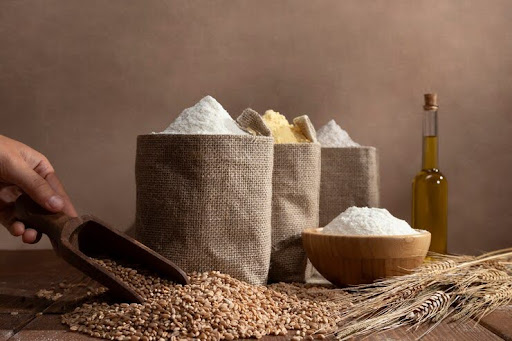In an technology wherein food picks have become increasingly more scrutinized, organic products have surged in popularity.
Among those, organic wheat flour stands out as a staple component in kitchens international. While traditional wheat flour has long been a kitchen staple, organic wheat flour gives a special technique—one that prioritizes environmental sustainability, health blessings, and taste.
In this newsletter, we delve into the elaborate journey from grain to goodness, exploring the world of natural wheat flour.
Understanding Organic Wheat
Organic wheat flour originates from organic wheat, cultivated without artificial insecticides, herbicides, or genetically modified organisms (GMOs).
This cultivation approach prioritizes soil health, biodiversity, and sustainability. Organic farmers hire herbal practices including crop rotation, composting, and biological pest manage to nurture the soil and plants.
The Benefits of Organic Wheat Flour
1. Nutritional Superiority: Organic wheat flour is often perceived as nutritionally superior to its traditional counterpart.
Studies recommend that natural vegetation can also incorporate better degrees of positive nutrients, together with antioxidants, nutrients, and minerals.
Additionally, natural farming practices sell soil fertility, that may beautify the nutritional content material of vegetation.
2. Reduced Exposure to Chemicals: Conventional wheat farming involves the use of artificial pesticides and herbicides, which may depart residues on the grains.
In comparison, organic wheat is cultivated with out these chemicals, lowering purchasers’ publicity to potentially harmful materials.
3. Environmental Sustainability: Organic farming practices prioritize environmental sustainability by minimizing soil erosion, maintaining water exceptional, and selling biodiversity.
By eschewing synthetic inputs, natural wheat cultivation helps mitigate environmental degradation and supports ecosystem health.
Production Process of Organic Wheat Flour
Among those, organic wheat flour stands out as a staple component in kitchens internationally. While traditional wheat flour has long been a kitchen staple, organic wheat flour gives a special technique—one that prioritizes environmental sustainability, health blessings, and taste.
In this newsletter, we delve into the elaborate journey from grain to goodness, exploring the world of natural wheat flour.
The production technique of natural wheat flour involves numerous key steps, each essential in retaining the integrity of the product:
1. Cultivation: Organic wheat cultivation starts with the selection of organic seeds and adherence to natural farming practices. Farmers nurture the soil via composting, cowl cropping, and herbal fertilization strategies.
2. Harvesting: Once the wheat reaches maturity, it’s far harvested the usage of sustainable strategies which includes combine harvesting or traditional hand harvesting, depending on the dimensions of the operation.
3. Milling: After harvesting, the wheat grains undergo milling to provide flour. In the milling procedure, the grains are wiped clean, tempered, and floor into flour using stone mills or metal curler mills.
Stone milling, a conventional technique, keeps more of the grain’s vitamins and taste compared to roller milling.
4. Packaging: The freshly milled organic wheat flour is then packaged in eco-friendly materials, frequently biodegradable or recyclable, to preserve its freshness and excellent.
5. Distribution: Organic wheat flour is distributed to outlets, bakeries, and clients through numerous channels, along with local markets, grocery stores, and online structures.
Applications of Organic Wheat Flour
Among those, organic wheat flour stands out as a staple component in kitchens international. While traditional wheat flour has long been a kitchen staple, organic wheat flour gives a special technique—one that prioritizes environmental sustainability, health blessings, and taste.
In this newsletter, we delve into the elaborate journey from grain to goodness, exploring the world of natural wheat flour. Organic wheat flour is a flexible element with numerous culinary packages:
1. Baking: Organic wheat flour is generally used in baking bread, desserts, cookies, pastries, and different baked goods. Its advanced texture and flavor contribute to the satisfactory of the very last product.
2. Cooking: Organic wheat flour serves as a thickening agent in sauces, gravies, soups, and stews. It can also be used to make pasta, noodles, dumplings, and different savory dishes.
3. Snacks: Organic wheat flour is the bottom ingredient for snacks including crackers, biscuits, and pretzels, supplying a more healthy alternative to conventional processed snacks.
4. Breakfast Foods: Pancakes, waffles, crepes, and truffles are only a few of the breakfast meals that may be made with natural wheat flour, providing a healthy start to the day.
Conclusion
Organic wheat flour embodies a commitment to sustainability, health, and fine. From its cultivation in natural fields to its transformation into flour thru traditional milling techniques, natural wheat flour represents the epitome of wholesome goodness.
Among those, organic wheat flour stands out as a staple component in kitchens international. While traditional wheat flour has long been a kitchen staple, organic wheat flour gives a special technique—one that prioritizes environmental sustainability, health blessings, and taste.
In this newsletter, we delve into the elaborate journey from grain to goodness, exploring the world of natural wheat flour.
Its dietary superiority, decreased chemical exposure, and environmental sustainability make it a favored choice for conscientious clients and discerning chefs alike.
As we retain to prioritize health and sustainability in our meals picks, natural wheat flour stands as a shining instance of grain-to-goodness excellence.
